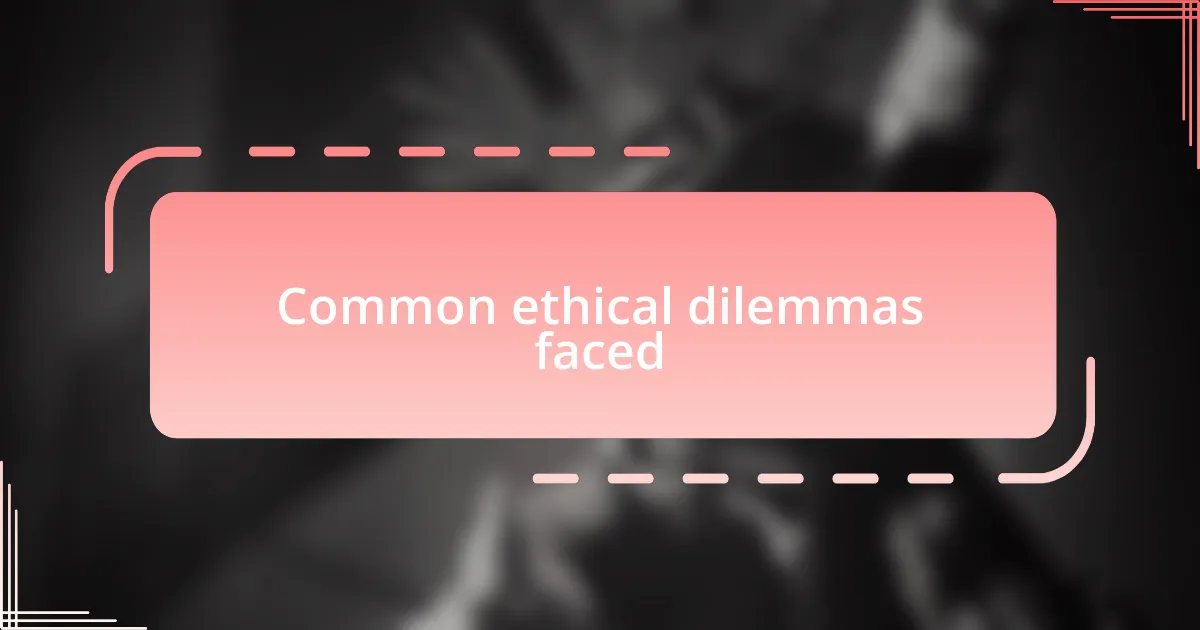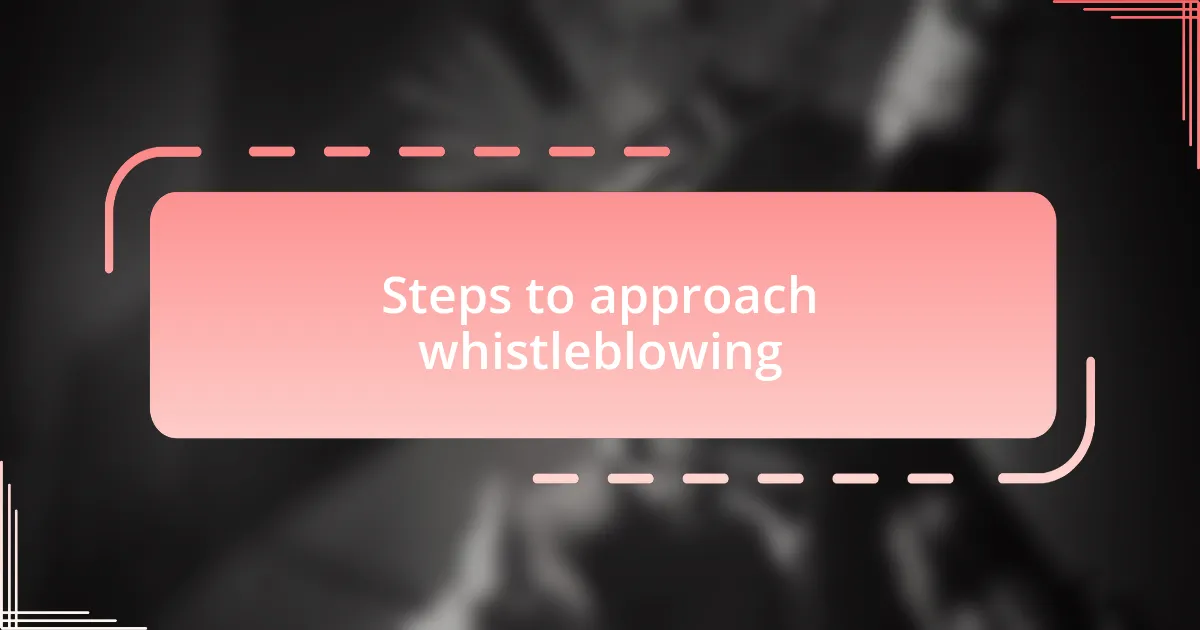Key takeaways:
- Whistleblowing in education involves moral dilemmas, often fueled by fears of retaliation and conflicts between loyalty and integrity.
- Recognizing misconduct can rely on intuition and observation, with signs including behavioral changes and inconsistencies in disciplinary actions.
- Effective steps for whistleblowing include documenting specific incidents, discussing concerns with trusted individuals, and approaching the reporting process with clarity.
- Personal experiences highlight the importance of courage in speaking up, as it can lead to accountability, support, and fostering change within an institution.

Understanding whistleblowing in education
Whistleblowing in education often surfaces when individuals witness misconduct like fraud, harassment, or safety violations. I remember a time during my teaching days when a fellow educator confided in me about questionable practices affecting students. That moment made me wonder: What drives someone to risk their career to expose wrongdoing?
The emotional weight of whistleblowing can be overwhelming. Imagine feeling torn between fidelity to your institution and the obligation to protect students or colleagues. I’ve found that the fear of retaliation often stops many educators from speaking out, leaving them in a moral dilemma that can feel isolating.
Understanding the implications of whistleblowing means recognizing its potential to foster a safer educational environment. It is crucial to arm ourselves with knowledge about support systems available for whistleblowers. Have you ever considered how different responses from a school administration could impact the decision to speak up? I’ve seen that a nurturing approach can empower individuals to act in the best interest of their community.

Common ethical dilemmas faced
Ethical dilemmas in whistleblowing often revolve around the fear of repercussions. I recall a colleague who hesitated to report a breach of trust involving student data because they feared losing their job. That dilemma illustrates a painful truth: the cost of speaking out can feel insurmountable when personal security is at stake.
Another common challenge lies in the conflict between loyalty and integrity. I’ve had moments where I found myself wrestling with whether to support a friend in their questionable actions or to take a stand for what’s right. This inner turmoil can lead to sleepless nights, stressing over making the right choice for both personal relationships and the greater good.
Compounding these challenges, the varying support from institutions plays a significant role in the decision-making process. I once witnessed a principal who was dismissive when someone raised concerns about bullying among students. Such responses can create a chilling effect, making it less likely for individuals to step forward. Have you ever thought about how crucial supportive leadership is in encouraging honesty within schools?

Recognizing signs of misconduct
Recognizing signs of misconduct is often a blend of intuition and observation. I remember a time when I noticed subtle changes in a colleague’s behavior—once enthusiastic about sharing lesson plans, they became increasingly withdrawn. This shift isn’t just personal; it can signal deeper issues, perhaps related to how they were treated or ethical lines being crossed.
I’ve encountered situations where uncharacteristic secrecy raised red flags for me. For example, when a teacher began closing their classroom door for long periods during lunch breaks and started to avoid staff meetings, it didn’t sit right with me. Have you ever felt that gnawing suspicion that something wasn’t quite right? It’s essential to trust those instincts, as they can often point to larger problems that might affect everyone involved.
Patterns of inconsistency can also be a giveaway. If, for instance, a school’s disciplinary actions seem erratic and favor certain students over others, it can imply that something is amiss. Noticing these discrepancies can be the first step in recognizing potential misconduct, urging us to be vigilant and proactive rather than passive observers.

Steps to approach whistleblowing
When considering the steps to approach whistleblowing, the first thing I advocate for is gathering your thoughts clearly. I recall a time when I witnessed a troubling incident that made me uneasy. Instead of reacting immediately, I took a moment to jot down my observations and feelings. This not only helped me articulate the issue more effectively, but it also provided a sense of clarity in a chaotic situation. Have you ever felt overwhelmed by emotions and later realized they clouded your judgment? Writing things down can give you perspective and a more rational approach.
Next, I believe it’s crucial to speak to someone you trust, be it a colleague or a mentor. In one instance, I reached out to a trusted friend who worked in administration after observing unethical behavior among staff. Just discussing my concerns allowed me to refine my understanding of the situation and consider my options carefully. The support of an outside perspective can alleviate the isolation one feels in these circumstances, don’t you think? It’s comforting to have someone validate your concerns and encourage you to proceed with caution.
Finally, when you’re ready to act, documenting the specific instances of misconduct is vital. In my experience, I’ve found that precise details—dates, times, and specific actions—carry significant weight. After reporting a serious concern, I ensured I had everything in writing. This documentation not only reinforces your claims but also provides a formal structure to your complaint, ensuring it is taken seriously. Have you ever noticed how clear evidence can change the course of a conversation? It’s a powerful tool in advocating for what’s right.

Personal experiences with whistleblowing
In my own experience, the moment I decided to speak up was fraught with anxiety. I remember standing in the break room, my heart racing, as I faced the choice of reporting a colleague’s inappropriate comments. It felt like being caught between loyalty and integrity. Have you ever feared the potential fallout from being honest about wrongdoing? That fear can be paralyzing, yet I found that embracing it was the first step toward reclaiming my sense of agency.
One particular instance stands out vividly. I took a deep breath and approached my supervisor, fully aware of the risks involved. As I shared my concerns, I felt a mix of vulnerability and relief wash over me. Then came the unexpected twist: my supervisor thanked me for my courage and assured me of the protection in place for whistleblowers. How often do we underestimate the power of speaking up? That moment taught me that transparency not only fosters accountability but can also create a supportive environment for change.
Reflecting on that experience, I’ve realized that whistleblowing is not simply about exposing faults—it’s also about advocating for those who may not have a voice. I vividly recall receiving supportive emails from colleagues who had been silently affected by the same issues I raised. Did you ever think that your voice could inspire others to come forward? In my case, it opened a channel for dialogue and healing, reminding me that actions can ripple out in ways we might not expect.